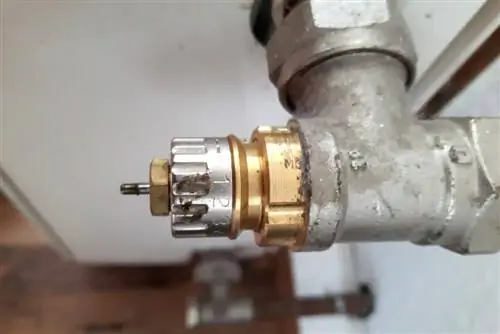- Author admin [email protected].
- Public 2023-12-17 03:39.
- Last modified 2025-06-01 06:48.
Setting and changing the heating thermostat only requires a few steps if you know how to do it. The measures can also help save heating energy and heat rooms more efficiently. Therefore, checks should be carried out regularly to avoid wasting energy and money. If problems arise, they can usually be remedied in just a few simple steps.
Thermostat - how it works
The heating thermostat is a handle used to adjust the temperature. The handle operates a dial and the heater valve, which in turn controls how much heated water goes into the heater.
If the valve or regulator is defective, this can result in several problems:
Radiator no longer gets warm
If the control is moved and the radiator still remains cold, this is usually due to a stuck valve. In this case, the thermostat head does not necessarily have to be changed; lubricating the valve with suitable products can be enough to restore function.
Radiator doesn't get warm enough
If the thermostat head is set to the highest level and the radiator still remains cold or lukewarm, it is more than annoying. In addition to a lack of comfort due to the cold, he alth problems can also arise, as cold walls and inadequate heating increase the risk of mold formation.
Radiator gets too warm
If the radiator becomes very warm or even hot even at low settings, energy is being wasted unnecessarily. This not only puts a strain on the budget, but also on the environment. The culprit here is usually a heating valve that opens too much too quickly. Applying a lubricant such as WD-40 can also help in these cases. However, the setting must also be changed to achieve the desired adjustment.
Replacing the thermostat - instructions
If the temperature output no longer matches the set level, removing the thermostat is the first step to solving the problem. To do this, proceed as follows:
- The nut is grasped and fixed with a pipe wrench or a suitable wrench or nut wrench.
- The handle is loosened and turned loosely in an anti-clockwise direction.
- The valve is located under the handle. From the outside, this can only be seen as a rod, which should normally be relatively easy to push in. However, dirt, dust and foreign objects can get stuck on them. Rust can also form. It is therefore important that all dirt and foreign bodies are removed first. As a rule, it is sufficient to wipe the valve with a soft, lint-free cloth. Applying a lubricant can also help loosen and remove tougher contaminants.
- If the thermostat head can still be turned and moved without any problems, it is not necessary to change it. In this case, cleaning and reattaching are sufficient.
- If functionality is still present, the handle can simply be reattached and screwed tight. The nut is rotated clockwise.
- Finally, it must be tested whether the cleaning and lubricant have restored full control and functionality. The pin of the valve should also be easy to press in.
Tip:
If the controller is set to the highest level, the heating thermostat can be removed and reattached particularly easily. Therefore, when unscrewing or replacing, care should be taken to ensure that the radiator is in this setting level.
Install new thermostat head
Mounting or replacing a new heating thermostat is just as easy as removing or lubricating an old thermostat. The following step by step instructions show how it works:
- Set the control to the highest level to make losing weight easier.
- Use pliers to remove the nut counterclockwise.
- Clean the area under the thermostat head and spray or wipe with lubricant.
- Put on the new thermostat and install it by tightening the nut. Make sure that the button is set to the highest setting.
Tip:
In addition to the rotary controls with printed heat levels, you can also find versions with a digital temperature display in hardware stores and electronics stores. These can make operation easier. Wireless thermostats also provide a more convenient control option.
Change wireless thermostat
If a wireless thermostat needs to be changed, a little more effort may be required. The change itself does not differ from the procedure described. However, it may be necessary to replace the temperature sensor and the control element.
If a wireless thermostat is installed for the first time, these elements must also be installed. The effort required for this is higher, but the operation is much more convenient. Thanks to modern designs, it is even possible to control the heating via an app and the WiFi in the house or apartment. In this way, the heating can be turned off or turned down when you are away and then turned up again before you arrive home. This saves energy and costs and the apartment is still warm.
Thermostatic valve - setting
During assembly, an incorrect setting level may be displayed if the valve head is not positioned correctly. Not only will this cause the wrong numbers to be displayed, but it can also cause problems regulating the temperature. It is therefore important that you pay close attention to the setting the controller is in when attaching it.

The easiest way is to set the control to either the lowest or highest level when it is removed. If, despite this procedure, the heater does not heat properly, the control knob stalls or turns too “softly” - i.e. no resistance is felt - the pin of the valve should be checked again. It is also possible that it needs to be replaced or that the problem can be found somewhere else. In these cases, professional repairs must be carried out.






